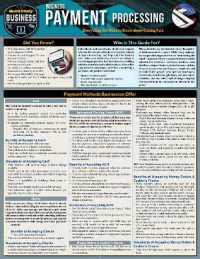- ホーム
- > 洋書
- > 英文書
- > Nature / Ecology
Full Description
In this book, first published in 1983, internationally known experts provide a comprehensive view of current knowledge of social insect biology including much previously unpublished information. Particular emphasis is given to the relationships between social insects and humans; sections are devoted to economically important social insects, pollination, foraging, and the role of insects in ecosystems and agroecosystems. The authors also discuss communication, behavior and caste within insect colonies. A special section focuses on the neurobiology of social insects. A series of papers considers the presocial insects, which live in family groups but without caste differences. Also well represented are the fields of sociobiology and the origins and evolution of social behavior. The book will be valuable to agricultural scientists as well as to entomologists, sociobiologists, ecologists, ethologists, and natural historians. Endocrinologists and neurobiologists will also find important new material.
Contents
Preface -- Plenary Addresses -- Of Insects and Man -- On Insects and Insects: Twists and Turns in Our Understanding of the Evolution of Eusociality -- Foraging Behavior and Pollination -- Introduction -- Competition Among Social Species -- Nectar Biology and Pollinator Attraction in the North Temperate Climate -- Information Used in Foraging -- Random and Systematic Search in Foraging Insects -- Abstracts -- Competition and Population Dynamics in Social Insects -- Introduction: The Wood and the Trees -- A Comparison of the Ground Dwelling Ant Populations Between a Guinea Savanna and an Evergreen Rain Forest of the Ivory Coast -- Population Dynamics in an African Fungus-Growing Termite -- Interactions Among the Four Species of the Genus Apis -- Abstracts -- The Roles of Social Insects in Ecosystems -- Introduction -- Ecological Role of Termites in a Tropical Rain Forest -- A Population Dynamics Hypothesis for Vespula in England, U.K -- The Interaction and Impact of Domestic Stock and Termites in a Kenyan Rangeland -- Comparative Early Growth and Foraging of Two Naturally Established Vespine Wasp Colonies -- Ant Manipulation in Agro-and Forest-Ecosystems -- Behavioral Ecology of the Army Ant Neivamyrmex nigrescens in a Desert-Grassland Habitat -- Abstracts -- Economically Important Social Insects -- Introduction -- Economics and Control of Yellowjackets (Vespula, Dolichovespula) -- The Economic Importance of Leaf-Cutting Ants -- Control of Monomorium pharaonis (L) with Methoprene Baits: Implications for the Control of Other Pest Species -- Economic Aspects of the Imported Fire Ant in the United States -- The Impact on Man of Polistes Wasps with Special Reference to Caterpillar Suppression -- The Economic Impact of the Africanized Honey Bee in South America -- The Economic Importance of Termites in North America -- Economically Important Termites of the Oriental Regions and Their Management -- Abstracts -- Presocial Behavior -- Introduction -- Soldiers and Altruistic Dispersal in Aphids -- Communal Nesting in Australian Cerceris Digger Wasps -- Evolved Relations Between Reproductive and Subsocial Behaviors in Coleoptera -- Further Experiments on the Artificial Induction of Multifemale Associations in the Principally Solitary Bee Genus Ceratina -- Selective Factors Associated with the Evolution of Membracid Sociality -- Abstracts -- The Evolution and Ontogeny of Eusociality -- Introduction -- A Comparative Study of Social Structure in Colonies of Ropalidia -- Liostenogaster flavolineata: Social Life in the Small Colonies of an Asian Tropical Wasp -- The Social Structure of Bombus terrestris Colonies: A Review -- Trophallaxis and the Evolution of Eusocial Hymenoptera -- Multiple Primary Queens in Termites: Phyletic Distribution, Ecological Context, and a Comparison to Polygyny in Hymenoptera -- Intra-Colonial Competition in Ants, with Special Reference to the Genus Myrmica -- Abstracts -- Caste and Ergonomics -- Introduction -- The Role of Young Workers in Myrmica Colony Development -- Juvenile Hormone and Aggression in the Honey Bee -- Queen Number and Colony Ergonomics in Leptothorax longispinosus -- Egg Dimorphism and Male Production in Formica polyctena Foerster -- Abstracts -- Predation, Social Parasitism, and Defense -- Introduction -- How the Slave-Making Ant Harpagoxenus americanus (Emery) Affects the Pupa-Acceptance Behavior of Its Slaves -- Evolutionary Trends in the Parasitic Ant Genus Epimyrma -- Comparative Behavior of Social Wasps When Attacked by Army Ants or Other Predators and Parasites -- Social Insects in the Aftermath of Swarm Raids of the Army Ant Eciton burchelli -- Predation, Defense, and Colony Size and Cycle in the Social Wasps -- Colony Defense Strategies of Honeybees in Thailand -- Abstracts -- Communication -- Introduction -- The Adaptive Value of Probabilistic Behavior During Food Recruitment in Ants: Experimental and Theoretical Approaches -- Antennal Communication and Food Exchange in the Domestic Bee Apis mellifica L -- Behavior Genetics of Honey Bee Alarm Communication -- Chemical Communication in Ants: New Exocrine Glands and Their Behavioral Function -- Compositional Variability: The Key to the Social Signals Produced by Honeybee Mandibular Glands -- Communication and the Swarming Process in Honeybees -- Abstracts -- Neurobiology and Behavior of Social Insects -- Introduction -- Rapid Changes in Dendritic Spine Morphology During the Honeybee's First Orientation Flight -- Electrophysiological Analysis of Central Neurons in the Bee and Correlations with Behavior -- Neuronal (?) Control of Heart Rate in Honey Bees -- Circadian and Other Non-Visual Inputs to Identified Visual Interneurones in the Honey Bee -- Short-Term Memory in the Honey Bee -- The Effects of Amines on Behavior and Neural Activity in the Honey Bee -- The Neural Architecture of the Honeybee Mushroom Bodies -- Modulation of Neurosecretion During Caste Determination in Apis mellifera Larvae -- The Bee's Celestial Map- A Simplified Model of the Outside World -- Basic Mechanisms of Sensory Antennal Information Processing in Insects, with Special Reference to Social Insects -- Disruption of Ant Recruitment by the Frontal Gland Secretion of a Termite: A Chemical Defense Strategy -- On Synaptic Connexions, Tracts and Compartments in the Brain of the Honeybee -- Abstracts -- Abstracts: General Topics*








